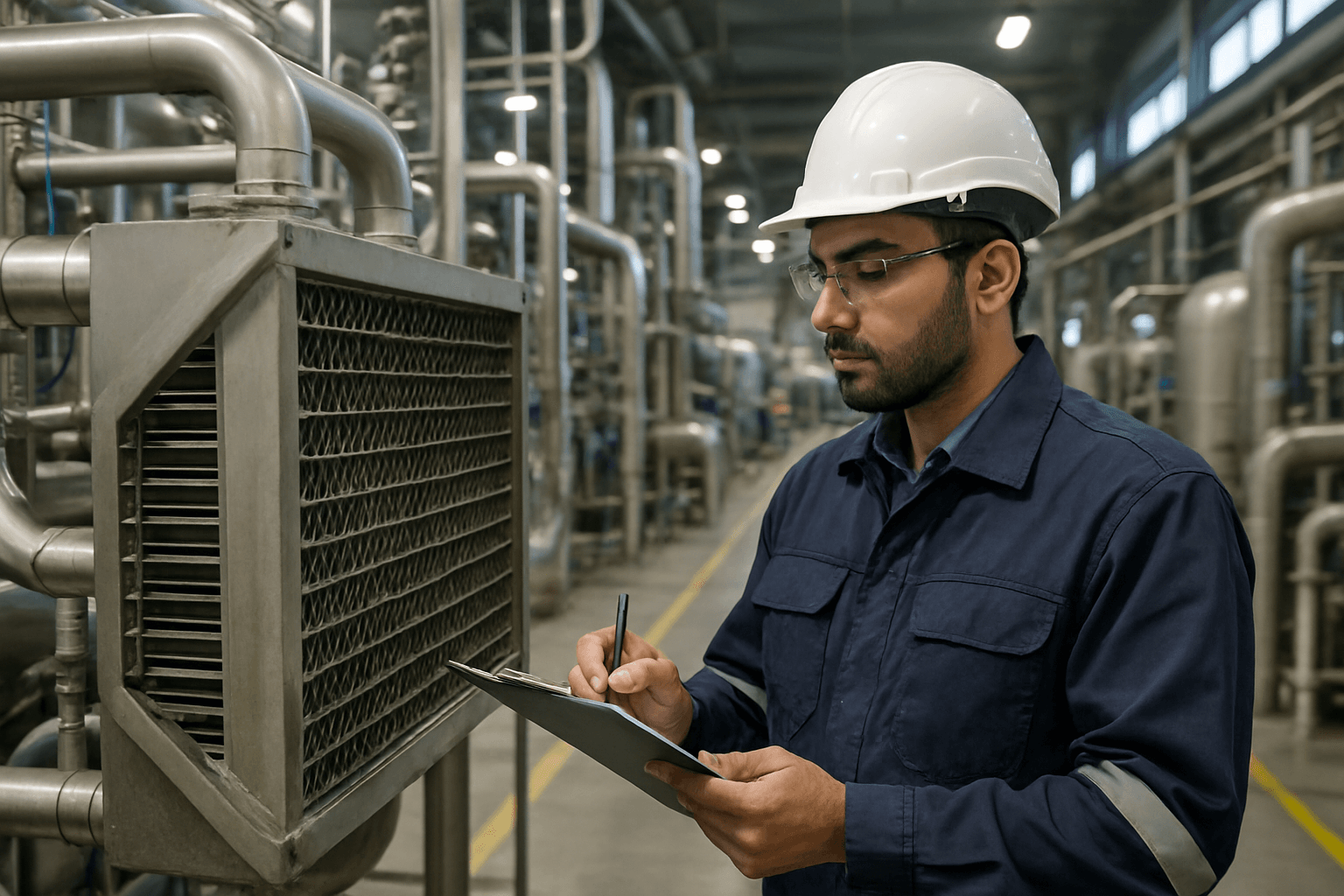As the global push for a sustainable energy future accelerates, hydrogen production is emerging as a critical component, offering a clean fuel source and an essential industrial feedstock. However, the energy-intensive nature of many hydrogen production processes, particularly steam methane reforming (SMR) or electrolysis, presents a significant challenge to overall efficiency and cost-effectiveness. A crucial technology in addressing this challenge is the implementation of air-to-air heat exchangers, which play a pivotal role in waste heat recovery and energy optimization within these complex facilities. By effectively reclaiming valuable thermal energy, these systems can dramatically improve process efficiency, reduce operational costs, and lower the carbon footprint of hydrogen production.
The Imperative of Waste Heat Recovery in Hydrogen Production
Hydrogen production, regardless of the method, often generates substantial amounts of waste heat. For instance, in steam methane reforming (SMR), high-temperature flue gases are a byproduct of the reformer furnace. In electrolysis, while often considered cleaner, there are still thermal management requirements for optimizing cell performance and managing auxiliary systems. This wasted energy represents both a lost opportunity for efficiency gains and a contributor to operational expenses. Implementing robust waste heat recovery systems is not merely an option but a necessity for making hydrogen competitive and truly sustainable.
Understanding the Energy Landscape of Hydrogen Facilities
Modern hydrogen plants, particularly those utilizing SMR, involve several high-temperature stages. The reformer itself operates at extreme temperatures to facilitate the chemical reactions. Post-combustion, the hot flue gases carry away a significant portion of the input energy. Similarly, in high-temperature electrolysis (HTE), maintaining specific thermal conditions is vital, and managing the heat generated or required by the process streams offers opportunities for recovery.
Benefits of Energy Recovery in Hydrogen Production
The integration of waste heat recovery via air-to-air heat exchangers yields multiple advantages:
- Reduced Fuel Consumption: By preheating combustion air or process streams, the demand for primary fuel (e.g., natural gas in SMR) is significantly reduced.
- Lower Operating Costs: Decreased fuel consumption translates directly into substantial cost savings over the operational lifespan of the plant.
- Enhanced Process Efficiency: Reclaiming heat means more of the input energy is utilized for the desired chemical reactions or processes, boosting overall efficiency.
- Reduced Emissions: Less fuel burned leads to a reduction in greenhouse gas emissions and other pollutants, aligning with sustainability goals.
- Improved System Stability: Stable preheated air or gas flows can contribute to more consistent and controllable process conditions.
How Air-to-Air Heat Exchangers Work in Practice
Air-to-air heat exchangers are devices designed to transfer thermal energy between two air (or gas) streams without direct contact or mixing. In hydrogen production facilities, they are primarily used to recover heat from hot exhaust gases and transfer it to a cooler air stream, typically combustion air or other process air requiring preheating.
Core Principles of Heat Transfer
These exchangers operate on the fundamental principles of convection and conduction. Hot exhaust gases flow on one side of a metallic plate or tube, transferring heat by convection to the surface. This heat then conducts through the material of the heat exchanger element and is subsequently transferred by convection to the cooler incoming air stream on the other side. The efficiency of this transfer is influenced by the temperature difference between the streams, the surface area available for heat exchange, and the material’s thermal conductivity.
Common Types and Their Application
Several designs of air-to-air heat exchangers are suitable for industrial applications like hydrogen production:
- Plate Heat Exchangers: Comprising a series of parallel plates, these offer a large surface area in a compact design. Hot and cold air streams flow in alternating channels. They are known for their high efficiency and can handle significant temperatures, though material selection is crucial for corrosive environments.
- Tubular Heat Exchangers: These consist of a bundle of tubes housed within a shell. One fluid flows through the tubes, and the other flows around the tubes within the shell. They are robust and can handle high pressures and temperatures, making them suitable for demanding industrial environments.
- Rotary Heat Exchangers (Heat Wheels): A rotating matrix (often corrugated metal) continuously absorbs heat from the hot exhaust stream and releases it to the incoming cold air stream. While highly efficient, their moving parts require more maintenance, and cross-contamination can be a concern depending on the application.
- Run-Around Coil Systems: These use two separate coil units connected by a pumped liquid loop (e.g., glycol-water solution). One coil extracts heat from the exhaust, and the liquid carries it to the second coil, which transfers it to the incoming fresh air. This system prevents cross-contamination and allows for spatial separation of the air streams.
For hydrogen production, robust and high-temperature tolerant designs like tubular or specialized plate heat exchangers are often preferred due to the nature of the hot flue gases and the desire to minimize cross-contamination.
Integrating Heat Exchangers into Hydrogen Production Processes
The specific integration points for air-to-air heat exchangers depend on the hydrogen production method.
Steam Methane Reforming (SMR) Facilities
In SMR, natural gas is reacted with steam at high temperatures to produce hydrogen and carbon monoxide, followed by a water-gas shift reaction and purification. The reformer furnace is a major energy consumer, and its flue gases are a prime target for heat recovery.
- Combustion Air Preheating: One of the most common and effective applications is preheating the combustion air supplied to the reformer furnace burners. Hot flue gases from the furnace exit at temperatures that can exceed several hundred degrees Celsius. An air-to-air heat exchanger captures this heat and transfers it to the cooler incoming combustion air, significantly reducing the amount of fuel required to reach the desired furnace operating temperature.
- Process Air/Steam Preheating: In some configurations, recovered heat can also be used to preheat incoming process air or to generate low-pressure steam, further improving overall plant efficiency.
Electrolysis-Based Hydrogen Production
While not generating flue gases in the same manner as SMR, electrolysis plants can still benefit from heat exchange:
- Thermal Management of Electrolyzers: Maintaining optimal operating temperatures for electrolyzers is critical for efficiency and longevity. Air-to-air heat exchangers can be used in the balance of plant to cool auxiliary equipment or recover heat from cooling circuits for other uses.
- Drying and Conditioning Process Air: If air separation units are involved or if process air needs specific conditioning (e.g., drying) before entering certain stages, heat exchangers can play a role in efficient temperature management.
Key Considerations for Design and Implementation
Implementing air-to-air heat exchangers in hydrogen production facilities requires careful planning and engineering to ensure optimal performance, reliability, and safety.
Material Selection
The materials of construction are paramount, especially given the high temperatures and potential for corrosive elements in flue gases from SMR. Stainless steels, specific alloys (e.g., Inconel, Hastelloy), or even ceramic materials may be required to withstand thermal stress, oxidation, and chemical attack over the long term.
Fouling and Cleaning
Industrial exhaust gases can contain particulates that lead to fouling on heat exchange surfaces, reducing efficiency. The design must account for ease of cleaning, either through integrated cleaning mechanisms (e.g., soot blowers) or accessibility for manual cleaning. Regular maintenance schedules are essential.
Pressure Drop and Fan Power
Introducing a heat exchanger into an air or gas stream will create a pressure drop, necessitating additional fan power. The design must strike a balance between heat recovery efficiency and the energy penalty associated with increased fan operation. Optimized flow paths and low-pressure-drop designs are crucial.
Temperature Differentials and Pinch Points
Effective heat transfer relies on adequate temperature differences. Engineers must identify “pinch points” – areas where temperature differences between streams are minimal – to ensure the heat exchanger can still operate efficiently. Careful thermal modeling is essential during the design phase.
Safety and Regulations
Given the presence of high temperatures and potentially flammable gases (in case of leaks or process upsets), safety features such as robust sealing, pressure relief mechanisms, and appropriate instrumentation are critical. Compliance with relevant industry standards and safety regulations is non-negotiable.
The Future of Efficient Hydrogen Production
As hydrogen production scales up to meet burgeoning demand, the drive for maximum efficiency and minimal environmental impact will only intensify. Air-to-air heat exchangers stand as a proven and evolving technology ready to meet this challenge. By meticulously recovering waste heat and integrating it back into the process, these systems are not just components but strategic assets that enhance the economic viability and ecological sustainability of hydrogen facilities worldwide. Continuous advancements in materials, design optimization, and smart control systems promise even greater efficiencies, further solidifying the role of sophisticated heat transfer solutions in the green energy revolution.

